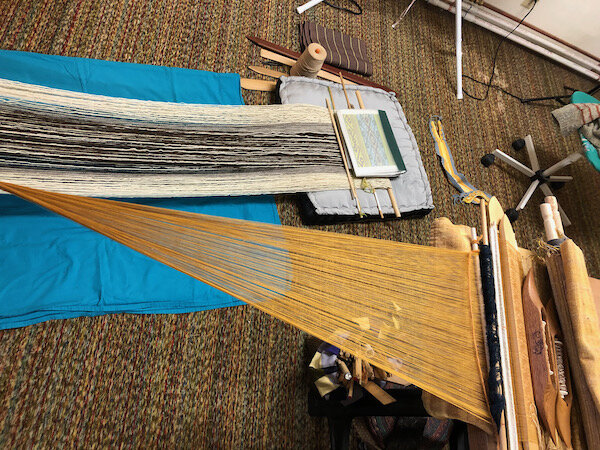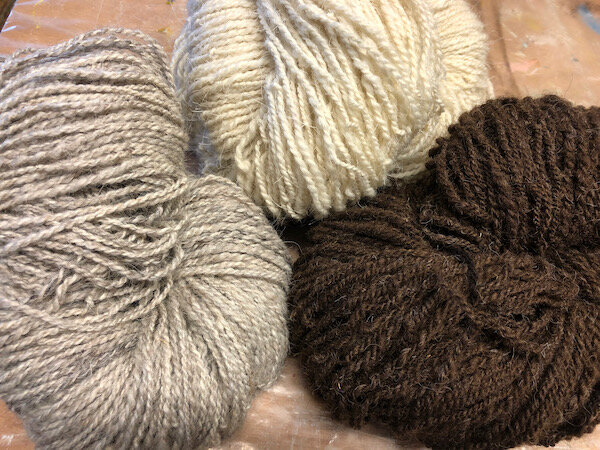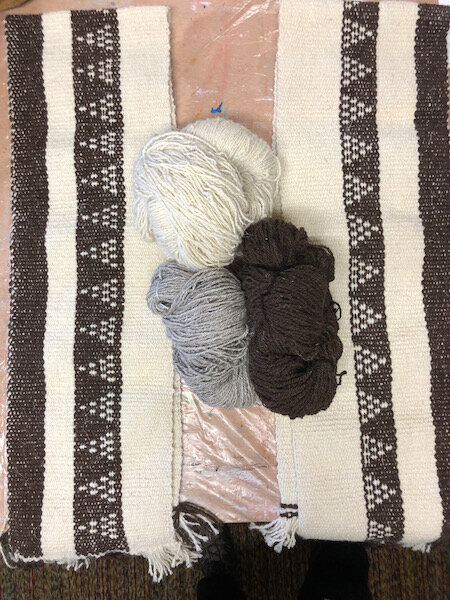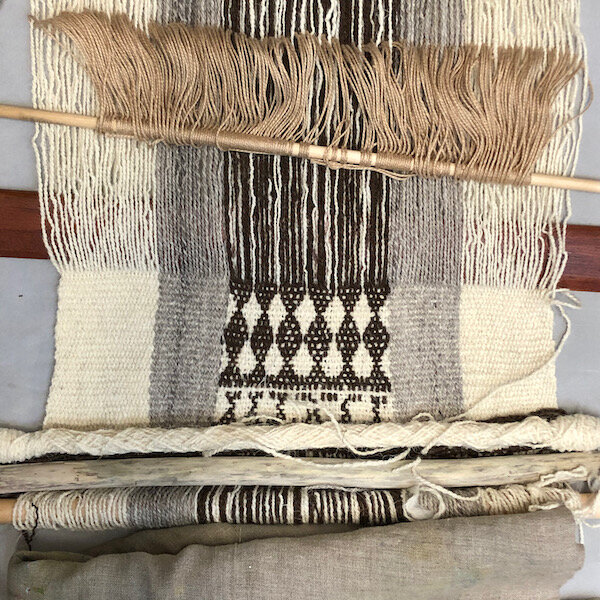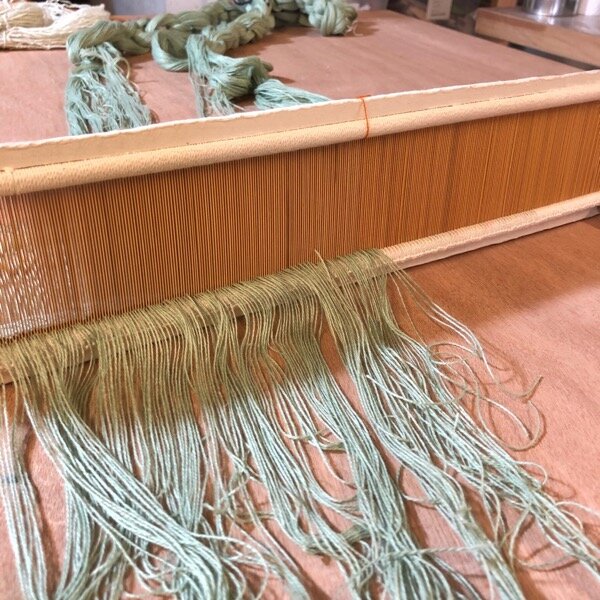As long as I have one, or two, or maybe more, weavings in progress, I feel secure in the knowledge that I have Something to Do. I can always put in a few rows or inches, especially if one of the projects is plain weave. I was happily, if slowly weaving along on the gold warp with a mishmash of weft yarns, destined to be several yards of 15” wide cloth for sewing, when another project suddenly took hold.
Double decker weaving. When you have one tie-up spot for larger pieces, they have to make way for one another. The gold warp is chained and secured at one point, so it can move side to side. I weave it while sitting in the rolling chair. The wool warp is secured on a loom bar, so it faces the tie-up (antique treadle sewing machine, that is) directly, and I sit on a cushion on the floor to weave it.
It all started with this Navajo churro fiber that Ameila G. was unloading before a big move. I happened to mention that I like that fiber, and a huge box came home with me. I spun the white and dark brown a few years ago, and the medium grey-brown just recently, a soothing pandemic spin. I had the skeins posed on my table to share a photo with my weaving friend.
Three shades of Navajo churro fiber, from the large stash I acquired thanks to Amelia Garripoli, spun and plied on my Louët S10 wheel.
Well, backing up, it all started when I had the idea to try to do a Bedouin-style weaving with the churro. Back in 2017, I started weaving the side panels - two strips that would mirror each other, with the patterning of al ‘ouerjan. The plan was to have a center strip with the shajarah supplementary warp technique, an improvised pickup which allows for the choice of dark or light color in each pattern warp in each shed. I’d learned the weaving methods while living in Doha, Qatar, through a combination of visiting Um Hamad, a Bedu/Qatari weaver in Souq Waqif, and consulting Joy Hilden’s book, which gave me the vocabulary to talk about the techniques with Um Hamad. I set up at home using my backstrap arrangement, rather than the ground loom or frame loom typical of Bedouin weavers, and while I wove a few practice pieces and made some projects with al ‘ouerjan, I only ever did the shajarah once, on a band which I later gave to Joy Hilden. So this idea for a larger weaving came from an urge to give “real” Bedouin weaving a try. What I mean by that is to use handspun wool of a heavy carpet weight, to do a warp-faced piece with multiple panels, and to use both types of supplementary warp technique. The pounds of churro fiber I had handy were just the thing.
In sending the photo to my friend, I then got out the side panels to show her what the yarn was for. And with everything sitting out and looking tantalizing, it was only a short step to winding a new warp. (This is why it’s important to have weaving friends.)
Brown and white wool side bands, and the three colors of yarn in the middle. Yeah, I can’t really figure out why the patterned bands are so different in these two, but I’m ignoring it. Symmetry is not my strong suit.
It had been so long (and had predated the sensible weaving notebook I now use) that I did not remember what length I had wound for the two warps. I decided, based on finished length, the most likely answer was “the full length of the table” - which is a standard unit of measure, at least in my studio.
Should I have put this behind a spoiler, for those who are made twitchy by the sight of a hectic warp? Sorry, this is my M.O. I wound in three bouts. I fixed tension issues in one set of white warps later, while getting set up on the loom bars. Joy’s book is open to some shajarah designs, to help me decide on the number of pattern warps to use.
For this supplementary warp technique, you wind one of each color held together for the full number of rounds equalling your desired pattern warps. I went for 30. Each shed thus gives all 30 warps, with the option to choose either dark or light for each one. Much improvisational freedom, with an emphasis on the smooth diagonal lines that are easy to achieve. The textiles I’ve seen seem to show a disregard for long floats on the backside, but I find myself designing in order to catch floats before they get too long. And as I wove, I realized this could explain the role of a certain type of framing I see in the pattern bands of Bedouin weavings. See Um Hamad’s work, below.
The very beginning - working out some kinks. A simple repeated hourglass pattern gives me a feel for the numbers and the pickup method, as I try to snug the warps closer together in the pattern section.
Um Hamad points out the patterns in a weaving. The rows of black diamonds seem to make boundary lines between designs, and would also serve to catch any long floats.
A weaving Um Hamad made in 2011, spinning and dyeing the yarn before weaving. Repeated rows of black diamonds again frame improvised sections of pickup.
The back of Um Hamad’s handspun piece, showing the floats in the shajarah section, and the bright orange, blue and red of the narrow stripes - dyed with packaged dyes from India, in a loosely plied skein. The yarn is plied tighter after dyeing.
Bedouin traditional looms have string heddles that are raised on props, with a shed stick behind them. The shed is opened in opposition to the raised heddles with a wide sword, or simply punched down, leaving the heddled warps raised. Raising my heddles with my hand and punching down the wool is a physically satisfying experience, getting me deeply involved with the wooly, three-dimensionality of my warp.
Heddles being raised, shed opening.
Having an improvisational design entices me to weave, with the promise of the unknown and the chance to experiment. This weaving has been a good place for me to settle during the past month.
More thorough explanation of Bedouin weaving as seen by me in Qatar, and lots of pretty pictures here.
Woven cloth with pickup design in the middle, grey stripes to either side, white borders that will join the white of the side panels. String heddles and shed stick behind. Heddled shed is open, design is picked up.
Souq Waqif rug arcade, Doha Qatar, 2011 Layered examples of different weaving styles.

